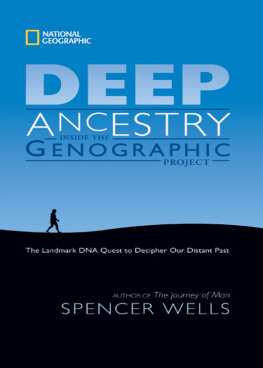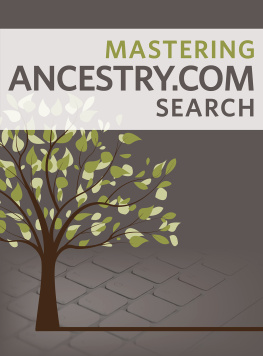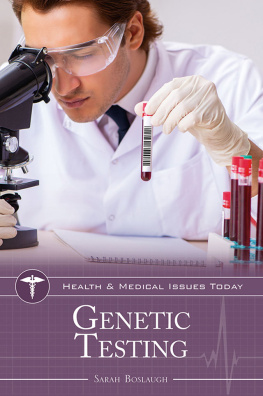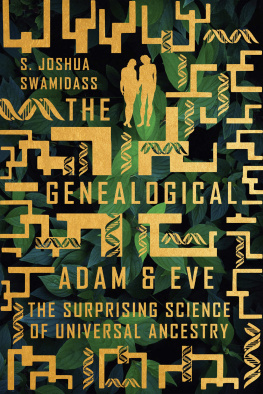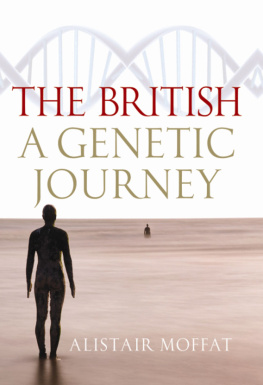Copyright 2006 National Geographic Society.
All rights reserved. Reproduction of the whole or any part of the contents without permission is prohibited.
Deep ancestry: inside the Genographic Project: the landmark DNA quest to decipher our distant past / by Spencer Wells.
p. cm.
Includes bibliographical references and index.
1. Genographic Project. 2. Human evolution. 3. DNA--Evolution. 4. Human genetics. I. Title.
Founded in 1888, the National Geographic Society is one of the largest nonprofit scientific and educational organizations in the world. It reaches more than 285 million people worldwide each month through its official journal, N ATIONAL G EOGRAPHIC , and its four other magazines; the National Geographic Channel; television documentaries; radio programs; films; books; videos and DVDs; maps; and interactive media. National Geographic has funded more than 8,000 scientific research projects and supports an education program combating geographic illiteracy.
For more information, please call 1-800-NGS LINE (647-5463) or write to the following address:
I NTRODUCTION
O n June 26, 2000, two geneticists stood with President Bill Clinton in the East Room of the White House. It was the end of a long journey for these two scientists as well as a public show of unity after a hard-fought battle to stake claim on the first complete sequence of the human genomethe 2.85 billion units that make up our genes. Francis Collins, a physician and a devout Christian, had led the publicly funded Human Genome Project. Craig Venter, taking his cues from Silicon Valley and the tech boom of the 1990s, had formed a private company to claim the same prize. Their rivalry would accelerate the pace of work to such an extent that the date of completion arrived a year earlier than expected. It was a great day to be a scientist, and I remember watching the event broadcast over the Internet from my laboratory in Oxford, hanging on every word.
What the announcement that day meant to science paled in comparison to what it will eventually mean to the public at large. That is why the U.S. president, arguably the most powerful man in the world at that time, was making the announcement rather than a spokesperson from the National Institutes of Health or the Department of Energy, which had funded much of the 13-year project. As Clinton said, it was the completion of the most important, most wondrous map ever produced by humankind.
This moment in many ways marked the beginning of the genomic era. Today the language of genetics has entered the zeitgeist of the modern age. References to DNA are used to sell everything from cars to computers. Genetics has become a genie of sorts, promising to grant our wishes with the magic spell of its hidden secrets. During the press conference at the White House, Clinton joked about living to 150. With advances in genetics this may actually be possible by the end of the 21st century, as our understanding of human diseases and aging expands. Almost daily, geneticists take incredible leaps forward in our understanding of ourselves.
LOOKING BACK
While much of the world that day was peering into the future, my colleagues and I were thinking about how this amazing new technology could be used to explore the past. Assembled in our small laboratory in Oxford were DNA samples from all over the world, a library of genetic information that we were using to deduce details about human history over the past 50,000 years. Our work, like that of most scientists, rested on the earlier achievements of brilliant researchers from around the world. What we had going for us was the benefit not only of their results but of the incredible new machines and techniques that had been developed for the Human Genome Project (HGP).
The HGP had begun slowly as an effort to map the large-scale structure of the genome. Beginning with a landmark meeting in Santa Fe, New Mexico, in 1986, the pace of work really gathered momentum in 1987 and 1988 when a 15-year plan was developed to undertake the sequencing. A large part of the early effort was focused on developing the technologies that were needed to plow through the huge amount of information. The HGP was gearing up to undertake something that many of us had only dreamed about a few years before, and genetics was on course to become big science in the way that physicswith its particle accelerators and large, international scientific consortiahad done decades before.
The pace of work was measured in the first few years of the project, as new techniques were evaluated and scientific methodologies were debated in scores of meetings and conferences. By the late 1990s, though, most of the major technical hurdles had been overcome, and spurred on in part by Venters privately funded efforts, the HGP was cranking out huge amounts of raw DNA sequence every day. The HGP had become a massive DNA sequencing factory.
Technology was clearly no longer the limiting factor in genetic research. Rather, it was access to the genetic texts we were trying to read. For instance, in our global effort to piece together genetic history, DNA samples donated by people interested in their own ancestry were relatively easy to obtain from places that had a well-developed scientific infrastructureEurope, the United States, and East Asia, for instancebut that left out most of the world. What our field of genetic anthropology needed was a truly global sampling of humanitys diversity. By analyzing samples from people who have been living in the same place for a long period of time, so-called indigenous people, it is possible to infer details about the genetic patterns of their ancestors. Furthermore, by making comparisons across many regions, it is also possible to say something about the movements of their ancestors thousands of years ago. But to do this with any accuracy, it is necessary to look at many, many people from around the world, particularly those living in relatively isolated locations.
Unfortunately, were racing against the clock. The stories carried in the DNA of indigenous people are being subsumed into the cultural melting pot. People move for three reasons: a lack of opportunities at home, the perception of better opportunities elsewhere, or forced relocation. Many of the worlds indigenous people are the poorest of the poor, residing in already poor parts of the world. Their traditional ways of life are threatened, and their children often leave home to join the economic mainstream in regional capitals or the growing megacities of the developing world. Once they enter the melting pot, their DNA loses the geographic context in which the genetic patterns create a clear trail.
The world is currently experiencing a cultural mass extinction similar to the biodiversity crisis. One symptom is the loss of languages. Linguists believe that as many as 15,000 languages may have been spoken in the year 1500, at the start of the European age of exploration. Today only 6,000 spoken languages are left, and perhaps as many as 90 percent of these will be lost by the end of this century. We are losing a language every two weeks through the same migration process that is mixing the worlds genetic lineages. While we hope that this will lead to a new sense of interconnectedness among the worlds peoples, it also means that the genetic trails we follow will become hopelessly intertwined. When this happens we will no longer be able to read the historical document encoded in our DNA.

